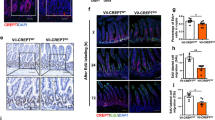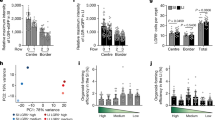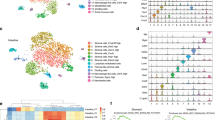Abstract
Reg I (regenerating gene product I) is a growth factor that plays a central role in the generation and regeneration of the gastric mucosal architecture. On the other hand, mouse Reg I mRNA is expressed at the highest levels in the small intestine among the gastrointestinal tissues. In the current study, with the aim to clarify the role of Reg I protein in the small intestine, the temporal and spatial pattern of Reg I expression and the phenotype of Reg I-knockout mice in the tissue were examined. In the wild-type mice, immunohistochemistry localized Reg I protein expression in absorptive cells located in the lower half of the intestinal villi. Reg I expression was undetectable until embryonic day 13 (E13), when the fetal intestine still lacks villous structure; however, it dramatically increased at E17 along with the formation and maturation of the fetal intestinal villi. In the small intestine of the adult Reg I-knockout mice, less densely packed, round-shaped aberrant morphology of the absorptive cells was observed light microscopically, and electron microscopical examination revealed a strikingly loose connection of these cells to the basement membrane. Antiproliferating cell nuclear antigen staining and anti-Ki67 staining demonstrated the marked decrease in the number of proliferating cells in the small intestinal mucosa of the knockout mice. The cell migration speed visualized by one shot labeling of 5-bromodeoxyuridine was significantly slower in the knockout mice. These phenotypes of Reg I-knockout mice emerged, in accordance with the temporal pattern of Reg I expression described above, from E17. Reg I was considered to be a regulator of cell growth that is required to generate and maintain the villous structure of the small intestine.
This is a preview of subscription content, access via your institution
Access options
Subscribe to this journal
Receive 50 print issues and online access
$259.00 per year
only $5.18 per issue
Buy this article
- Purchase on Springer Link
- Instant access to full article PDF
Prices may be subject to local taxes which are calculated during checkout






Similar content being viewed by others
References
Asahara M, Mushiake S, Shimada S, Fukui H, Kinoshita Y, Kawanami C et al. (1996). Reg gene expression is increased in rat gastric enterochromaffin-like cells following water immersion stress. Gastroenterology 111: 45–55.
Batlle E, Henderson JT, Beghtel H, van den Born MM, Sancho E, Huls G et al. (2002). Beta-catenin and TCF mediate cell positioning in the intestinal epithelium by controlling the expression of EphB/ephrinB. Cell 111: 251–263.
Brittan M, Wright NA . (2004). Stem cell in gastrointestinal structure and neoplastic development. Gut 53: 899–910.
Dempsey PJ, Goldenring JR, Soroka CJ, Modlin IM, McClure RW, Lind CD et al. (1992). Possible role of transforming growth factor alpha in the pathogenesis of Menetrier's disease: supportive evidence from humans and transgenic mice. Gastroenterology 103: 1950–1963.
Doolittle RF, Hunkapiller MW, Hood LE, Devare SG, Robbins KC, Aaronson SA et al. (1983). Simian sarcoma virus onc gene, v-sis, is derived from the gene (or genes) encoding a platelet-derived growth factor. Science 221: 275–277.
Downward J, Yarden Y, Mayes E, Scrace G, Totty N, Stockwell P et al. (1984). Close similarity of epidermal growth factor receptor and v-erb-B oncogene protein sequences. Nature 307: 521–527.
Fukui H, Kinoshita Y, Maekawa T, Okada A, Waki S, Hassan S et al. (1998). Regenerating gene protein may mediate gastric mucosal proliferation induced by hypergastrinemia in rats. Gastroenterology 115: 1483–1493.
Hartupee JC, Zhang H, Bonaldo MF, Soxares MB, Dieckgraefe BK . (2001). Isolation and characterization of a cDNA encoding a novel member of the human regenerating protein family: Reg IV. Biochim Biophys Acta 1518: 287–293.
Kadowaki Y, Ishihara S, Miyaoka Y, Rumi MA, Sato H, Kazumori H et al. (2002). Reg protein is overexpressed in gastric cancer cells, where it activates a signal transduction pathway that converges on ERK1/2 to stimulate growth. FEBS Lett 530: 59–64.
Kaneko Y, Sakakibara S, Imai T, Suzuki A, Nakamura Y, Sawamoto K et al. (2000). Musashi1: an evolutionally conserved marker for CNS progenitor cells including neural stem cells. Dev Neurosci 22: 139–153.
Kayahara T, Sawada M, Takaishi S, Fukui H, Seno H, Fukuzawa H et al. (2003). Candidate markers for stem and early progenitor cells, Musashi-1 and Hes1, are expressed in crypt base columnar cells of mouse small intestine. FEBS Lett 535: 131–135.
Kazumori H, Ishihara S, Hoshino E, Kawashima K, Moriyama N, Suetsugu H et al. (2000). Neutrophil chemoattractant 2 beta regulates expression of the Reg gene in injured gastric mucosa in rats. Gastroenterology 119: 1610–1622.
Kuhnert F, Davis CR, Wang HT, Chu P, Lee M, Yuan J et al. (2004). Essential requirement for Wnt signaling in proliferation of adult small intestine and colon revealed by adenoviral expression of Dickkopf-1. Proc Natl Acad Sci USA 101: 266–271.
Lickert H, Kispert A, Kutsch S, Kemler R . (2001). Expression patterns of Wnt genes in mouse gut development. Mech Dev 105: 181–184.
Macadam RC, Sarela AI, Farmery SM, Robinson PA, Markham AF, Guillou PJ . (2000). Death from early colorectal cancer is predicted by the presence of transcripts of the REG gene family. Br J Cancer 83: 188–195.
Miyaoka Y, Kadowaki Y, Ishihara S, Ose T, Fukuhara H, Kazumori H et al. (2004). Transgenic overexpression of Reg protein caused gastric cell proliferation and differentiation along parietal cell and chief cell lineages. Oncogene 23: 3572–3579.
Perfetti R, Egan JM, Zenilman ME, Shuldiner AR . (1996). Differential expression of reg-I and reg-II genes during aging in the normal mouse. J Gerontol A Biol Sci Med Sci 51: B308–B315.
Pinto D, Gregorieff A, Begthel H, Clevers H . (2003). Canonical Wnt signals are essential for homeostasis of the intestinal epithelium. Genes Dev 17: 1709–1713.
Potten CS, Booth C, Tudor GL, Booth D, Brady G, Hurley P et al. (2003). Identification of a putative intestinal stem cell and early lineage marker; musashi-1. Differentiation 71: 28–41.
Sbarbati R . (1982). Morphogenesis of the intestinal villi of the mouse embryo: chance and spatial necessity. J Anat 135: 477–499.
Sharp R, Babyatsky MW, Takagi H, Tagerud S, Wang TC, Bockman DE et al. (1995). Transforming growth factor alpha disrupts the normal program of cellular differentiation in the gastric mucosa of transgenic mice. Development 121: 149–161.
Stappenbeck TS, Wong MH, Saam JR, Mysorekar IU, Gordon JI . (1998). Notes from some crypt watchers: regulation of renewal in the mouse intestinal epithelium. Curr Opin Cell Biol 10: 702–709.
Takagi H, Jhappan C, Sharp R, Merlino G . (1992). Hypertrophic gastropathy resembling Menetrier's disease in transgenic mice overexpressing transforming growth factor alpha in the stomach. J Clin Invest 90: 1161–1167.
Terazono K, Yamamoto H, Takasawa S, Shiga K, Yonemura Y, Tochino Y et al. (1988). A novel gene activated in regenerating islets. J Biol Chem 263: 2111–2114.
Terazono K, Uchiyama Y, Ide M, Watanabe T, Yonekura H, Yamamoto H et al. (1990). Expression of reg protein in rat regenerating islets and its co-localization with insulin in the beta cell secretory granules. Diabetologia 33: 250–252.
Unno M, Nata K, Noguchi N, Akiyama T, Ikeda T, Nakagawa K et al. (2002). Production and characterization of Reg knockout mice: reduced proliferation of pancreatic beta-cells in Reg knockout mice. Diabetes 51: S478–S483.
van Es JH, Jay P, Gregorieff A, van Gijn ME, Jonkheer S, Hatzis P et al. (2005). Wnt signalling induces maturation of Paneth cells in intestinal crypts. Nat Cell Biol 7: 381–386.
Walters JR . (2005). Recent findings in the cell and molecular biology of the small intestine. Curr Opin Gastroenterol 21: 135–140.
Watanabe T, Yonemura Y, Yonekura H, Suzuki Y, Miyashita H, Sugiyama K et al. (1994). Pancreatic beta-cell replication and amelioration of surgical diabetes by Reg protein. Proc Natl Acad Sci USA 91: 3589–3592.
Yamamoto T, Nishida T, Miyajima N, Kawai S, Ooi T, Toyoshima K . (1983). The erbB gene of avian erythroblastosis virus is a member of the src gene family. Cell 35: 71–78.
Zenilman ME, Magnuson TH, Swinson K, Egan J, Perfetti R, Shuldiner AR . (1996). Pancreatic thread protein is mitogenic to pancreatic-derived cells in culture. Gastroenterology 110: 1208–1214.
Acknowledgements
We thank Dr T Chiba for valuable discussions.
Author information
Authors and Affiliations
Corresponding author
Rights and permissions
About this article
Cite this article
Ose, T., Kadowaki, Y., Fukuhara, H. et al. Reg I-knockout mice reveal its role in regulation of cell growth that is required in generation and maintenance of the villous structure of small intestine. Oncogene 26, 349–359 (2007). https://doi.org/10.1038/sj.onc.1209799
Received:
Revised:
Accepted:
Published:
Issue Date:
DOI: https://doi.org/10.1038/sj.onc.1209799
Keywords
This article is cited by
-
Interaction between gut microbiota and sex hormones and their relation to sexual dimorphism in metabolic diseases
Biology of Sex Differences (2023)
-
N6-methyladenosine modification of REG1α facilitates colorectal cancer progression via β-catenin/MYC/LDHA axis mediated glycolytic reprogramming
Cell Death & Disease (2023)
-
Gata4 is critical to maintain gut barrier function and mucosal integrity following epithelial injury
Scientific Reports (2016)
-
High Expression of Gastrin Receptor Protein in Injured Mucosa of Helicobacter pylori-Positive Gastritis
Digestive Diseases and Sciences (2013)
-
Involvement of the IL-22/REG Iα axis in ulcerative colitis
Laboratory Investigation (2010)



